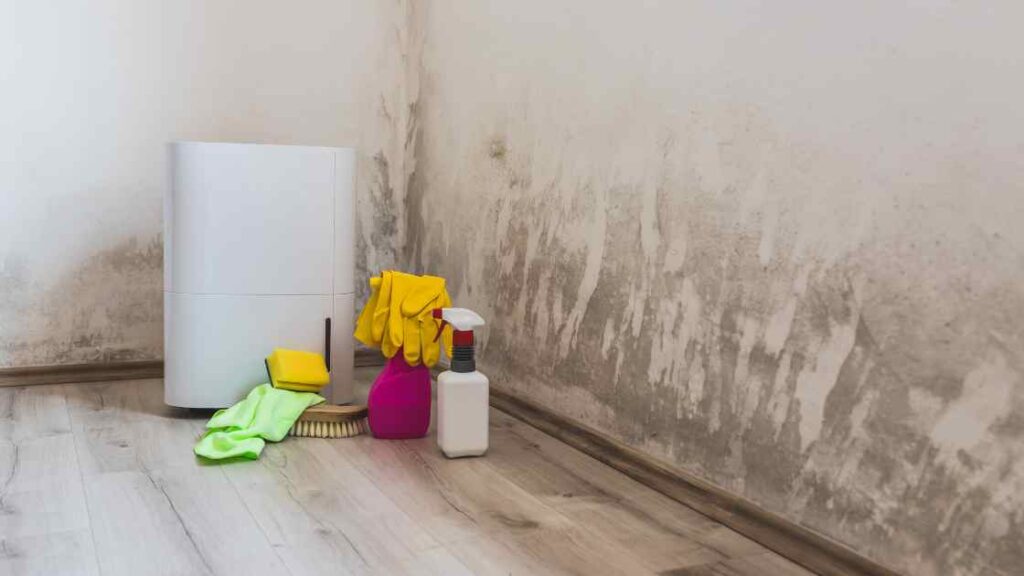Beat Basement Humidity: Best Dehumidifiers and Expert Tips

Does your basement seem like that forgotten land, doomed to darkness and forever shrouded by a chill dampness? Do you not like going down there because of the threat of musty odors and possible unwanted visitors in mold form? If so, then take heart: you’re not alone. Basements are, by their very nature, prone to moisture problems. But before you burrow into such a perpetually soggy situation, heaving in the wings is a hero—the dehumidifier. Now the question is why do I need a humidifier in my basement?
Now, will a dehumidifier be the appropriate weapon for waging a war against moisture? Let’s burrow into damp depths and turn up an answer!
Signs Why Do I Need a Dehumidifier in My Basement: The Silent Scream for Help
Before getting into dehumidifiers, let’s discuss the silent scream for help your basement may be giving. These signs all point toward one bad guy: too much moisture. Let’s ID the telltale villains, and learn about the damage they can do:
The Musty Menace:
That unmistakable musty smell is, well, a red flag for high humidity. Many describe it as earthy, stale, or even like mildew. This smell is created from the growth of mold and mildew. So, if your basement smells foul and that smell does not go away after airing it out, well, there’s your indication: moisture.
The Visible Villain:
Do you see condensation on walls, pipes, or windows? This is as clear a sign that will be provided about there being too much moisture in the air. Condensation occurs when warm, humid air reaches cooler surfaces. It shows up in droplets on walls, windows, even cold pipes. That not only leaves the place damp and miserable but also peels off paint from the walls, ruins the wallpaper, and if it goes on for long enough without correction, can cause structural problems.
Creepy Critters:
Moisture is the perfect environments for mold to grow, and your basement can become its playground if it’s not kept at bay. This can lead to the mold spores causing allergy symptoms or triggering asthma from its unpleasant odors. The main signs that indicate you need to address the moisture issues right away are visible mold growth on walls, ceilings, floors, and furniture. Also remember that mold can grow behind walls and under carpets, so mustiness of smell, even without other visible signs, can be cause for concern.
Warped Warriors:
Are your wooden basement treasures — furniture, doors, or trim — warping or cracking? Most assuredly, high humidity is wreaking havoc on your wood. Wood, as a rule of thumb, expands and contracts with changes in humidity. So, in an excessively wet basement, it absorbs the moisture, thereby swelling and warping. If this continues unabated, you are more than likely to encounter cracks, splits, and other structural harm in the long run.
The Rusty Rascals:
Rusty metal? That is an indication of moisture excess. As the level of moisture exceeds the required and recommended levels, metallic objects begin to rust. Therefore, when your tools or metal pipes or other such equipment in the basement have started rusting, know that there is excess moisture.
By being able to identify these signs, you will know when action concerning moisture in the basement is necessary to prevent irreparable damage to your health, belongings, and even the structure of your home.
You May Also Like to read: Revolutionizing Living: Top 20 Smart Home Gadgets 2024 Unveiled
The Dehumidifier: Your Damp-Busting Champion?
If you’ve counted off several of these signs, a dehumidifier may well be your knight in shining armor. It works this way: inlet of moisture-laden air, removal of extra moisture, and release of drier air back into the room. This brings down the humidity level to what is considered healthier and more comfortable.
Benefits of a Dehumidifier:
- Mold Inhibiting: Lower humidity, making conditions less hospitable for mold growth to benefit your health and protect your stuff.
- Improves Air Quality: Lower humidity eases allergy symptoms from allergic reactions to mold spores and dust mites that thrive in damp conditions.
- Protect Your Belongings: Less moisture, lesser the chance of wood warping, metal rusting, or damaging other stored items.
- Creates a More Pleasant Space: A dry basement feels more comfortable and inviting, hence more usable.
Do You Need a Dehumidifier? Unveiling the Moisture Mystery

Dehumidifiers are strong moisture fighters, but are they the appropriate solution for any basement? Let’s become moisture detectives and discover what factors can help you determine the answer:
Climate:
- Humidity Hotspot: Naturally humid climates, such as the Gulf Coast or the Southeast US, expose your basement to further moisture issues. In those regions, a dehumidifier will actually save the day by stopping mold growth and saving your personal belongings.
- Dry Desert Dweller: If you happen to reside in a dry climate, like some places in the Southwest US areas, then a dehumidifier might not be that useful. This is so because there will be less humidity available in basements within these regions.
- Basement Usage:
- Family Fun Zone: Do you use your basement as a living space, playroom, or home gym? Keeping the environment healthy and comfortable should always be maintained. A dehumidifier will protect against musty odors and mold growth or allergy cases usually triggered by high humidity levels.
- Rarely Visited Repository: If your basement is a storage space which you rarely visit, you may not be much concerned about a dehumidifier. But think about the value of things stored in your basement. With time, the high humidity in your basement can damage furniture, electronics, and important documents even in an area that is rarely used.
Ventilation:
- Flowing Avenger: Good airflow is one such natural nemesis of moisture. Does your basement have any windows you can open frequently? If it has vents with good airflow, it does much to reduce moisture.
- Flowing Enigma: In the absence of windows or good ventilation in your basement, a dehumidifier assumes greater importance. This is because a dehumidifier can independently remove excess moisture from the air in the basement, even in spaces with very poor airflow.
Beyond the Dehumidifier: Alternative Moisture Solutions
While dehumidifiers are certainly a powerful tool in the struggle against moisture, other strategies you could use include:
- Improved Ventilation: mounting vents or window fans can facilitate good air circulation and remove moisture organically.
- Plugging Leaks: whether through the foundation walls or faulty plumbing, cracks could turn out to be the source of moisture. Seal these leaks and fix the water sources so that the water doesn’t find its way into your basement and create moisture.
- Dehumidifying Paint: Use specially formulated dehumidifying paint on basement walls. This can help in soaking up excessive moisture from the air.
- Increase Basement Temperature: If you keep your basement a little warm, it will reduce condensation on walls and pipes. But ensure proper ventilation to avoid trapping heat with humidity.
- Choosing the Right Dehumidifier:
- In case a dehumidifier happens to be your champion, then consider these factors:
- Basement Size: Dehumidifiers come in different capacities; hence, choose one that will be able to effectively handle the size of your basement.
- Desired Humidity Level: ideal humidity levels for a basement are usually between 30% – 50%. Consider getting a dehumidifier with an adjustable set point so that you get the level you want.
- Drainage Options: Moisture collected by the dehumidifier is stored in a tank that requires emptying. Those with continuous drainage options should be considered to help you save time on maintenance.
5 Best Dehumidifiers on Amazon for Your Basement
Having identified the symptoms of excess moisture and the advantages a dehumidifier can offer, it is time to choose an appropriate product. Here are five top-rated Amazon products to give a dry and healthy basement environment:
Honeywell HFD30W 30 Pint Compact Dehumidifier
This compact dehumidifier has sufficient capacity to ensure basements with moderate humidity levels remain dry. It has a strong compressor that works powerfully and energy-efficiently, with a built-in humidistat for auto-control. The removable water tank is easy to empty, and there’s an option for continuous drainage when using the unit in large spaces.
Pros: Compact, Energy-efficient, Easy to use
Cons: Smallest capacity of the water tank compared to larger units.
Frigidaire FFAD3533W 35 Pint Dehumidifier
In cases when your basement is more humid, Frigidaire FFAD3533W will never disappoint. It offers high capacity dehumidification, several fan speed options, and is equipped with an integrated pump for continuous drainage. Other convenient features of the dehumidifier include auto-restart and defrost functions.
Pros: High capacity dehumidification, built-in pump, several fan speed options
Cons: Larger and heavier than some models
Black+Decker BDT50WTB 50 Pint Dehumidifier
This makes it perfect for those who have a large basement or the worst cases of humidity. Moisture removed per day is up to 50 pints, with a huge water tank capacity and a carrying handle for greater convenience. Laundry drying mode is also included in this dehumidifier.
Pros: High capacity in dehumidification, large water tank, laundry dry mode
Cons: Comparatively noisier
Midea Cube 50 Pint Smart Dehumidifier
Wi-Fi connectivity and voice control make the Midea Cube dehumidifier a great option for those in search of a smart home solution. Sleek design and very quiet with the ability to save on energy performance, the dehumidifier is also equipped with an air purifier for better air quality indoors.
Pros: Smart features, quiet, air purifier
Cons: More expensive than some models
Whynter DR-451WD 45 Pint Dehumidifier with Pump
If your basement is below grade, a dehumidifier with an internal pump becomes a necessity. The Whynter DR-451WD pairs potent dehumidification with a handy pump and multiple fan speeds. In addition, it has a washable air filter for indoor air quality.
Pros: Internal pump, washable air filter, multiple fan speeds
Cons: Larger and heavier than some models
How to Choose a Dehumidifier: A Comprehensive Guide

Getting the right dehumidifier can make all the difference in comfort and air quality in your home. Now, let us get into detail about choosing one:
Calculate the Right Size
Generally, the capacity of a dehumidifier is stated in pints, which is the measure of how much moisture it can remove from the air within 24 hours. Measure your space, weigh humidity levels against size charts, and note the probable shortcomings that come with oversizing or undersizing.
Really Sweat Energy Efficiency
An energy-efficient dehumidifier can save you a lot on utility bills. Seek the Energy Star certification, and compare the energy consumption rating of the product with that of others; some even have energy-saving modes and auto-humidistat functionality.
Address Noise Levels
If your basement is next to living areas, noise levels are a big factor. Check the decibel rating, consider the placement, and test the unit, if possible, for its noise level.
Explore Additional Features
Today’s dehumidifiers come with several features that make the operation process much smoother and more effective. This involves integral humidistats, continuous drainage, air purifying features, laundry drying modes, and smart features.
Maintain Your Dehumidifier at Peak Performance
Regular maintenance is the answer to maximum performance and longevity. Frequently clean the filters and empty the tank of water periodically. Check for mold and also consider professional maintenance for units with a complex design.
Use Customer Reviews to Your Advantage
Research customer feedback before you make a purchase to know what problems many customers tend to experience with a product, what it’s good for, and where one model stands compared to another.
Set a Realistic Budget
Know how much you can afford to pay for a dehumidifier by accounting for long-term expenses—striking a balance between price and features. Compare store prices to come up with one that best fits your budget.
Considering these factors will enable you to select a dehumidifier that will eliminate the humidity issue in your basement and be installed according to your needs and requirements.
Remember it can be quite useful to consult an HVAC professional. They can evaluate your situation in the basement and recommend the most effective moisture control solution for your needs.
Now, unwrap the mystery behind moisture and keep a healthy basement clean, comfortable, and safe by using these factors.









